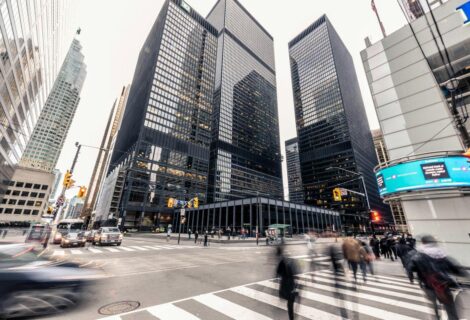Commercial real estate financing is a complex field that requires a deep understanding of various loan types, the intricacies of the application process, strategies for securing favorable terms, risk management, and an awareness of future trends. This comprehensive guide aims to equip developers and investors with the essential knowledge to navigate the landscape of loans available in the commercial real estate market. From term loans to fix and flip financing, and from application strategies to risk assessment, this guide covers all the crucial aspects to help you make informed financing decisions.
Key Takeaways
- Understanding the different types of commercial real estate loans, including term loans, bridge loans, DSCR loans, and rehab loans, is fundamental for developers and investors.
- The application and approval process for commercial loans is rigorous and requires thorough documentation, creditworthiness assessment, and an understanding of the timeline.
- Developing relationships with lenders like AMZA Capital can be advantageous in securing favorable loan terms, such as competitive interest rates and loan-to-value ratios.
- Effective risk management involves assessing financial risks, understanding market conditions, and safeguarding investments with appropriate insurance and guarantees.
- Staying abreast of future trends, including the rise of alternative lending platforms, regulatory changes, and loan product innovations, is crucial for long-term success in commercial real estate financing.
Understanding Different Types of Commercial Real Estate Loans

Term Loans and Their Structuring
Term loans are a fundamental component of commercial real estate financing, offering developers and investors a predictable repayment schedule and interest rate. Term loans are typically amortized over a set period, which can range from 5 to 30 years, depending on the nature of the project and the lender’s requirements.
When structuring a term loan, it’s crucial to consider the amortization schedule and the potential for balloon payments at the end of the term. A common structure includes:
- Initial interest-only period
- Gradual principal repayment
- Balloon payment (if applicable)
The right loan structure can significantly impact the overall cost of borrowing and the project’s cash flow.
Understanding the nuances of term loan structuring is essential for aligning financing with the project’s timeline and cash flow projections. Lenders may offer flexibility in terms, but this often comes with trade-offs in interest rates or upfront fees.
Bridge Loans: Bridging the Gap in Financing
Commercial bridge loans serve as an essential tool for developers and investors who need to manage cash flow effectively while waiting for long-term financing to come through. These loans offer a temporary solution, ensuring that projects can continue without financial interruption. Bridge loans are typically used to cover immediate expenses, such as balloon payments, or to take advantage of time-sensitive opportunities.
Bridge loans are designed to be short-term, often with terms ranging from a few months to a couple of years. They are secured by the property itself and usually require a clear exit strategy for repayment.
The flexibility of bridge loans makes them a popular choice for those in commercial real estate. However, it’s important to understand the costs associated with this type of financing, which can include higher interest rates and fees compared to traditional loans. Here’s a quick overview of key considerations:
- Interest Rates: Generally higher than long-term financing options.
- Loan Terms: Short duration, requiring prompt repayment.
- Exit Strategy: Must be well-defined and feasible.
- Fees: Can include origination fees, closing costs, and others.
Securing a bridge loan can be a strategic move for those who are confident in their ability to repay the loan within the short timeframe or who expect to secure long-term financing imminently.
The Role of DSCR Loans in Investment Properties
Debt Service Coverage Ratio (DSCR) loans have become a cornerstone in the financing of investment properties. These loans are evaluated based on the property’s ability to generate enough income to cover the loan payments, which is a critical factor for lenders. A DSCR loan is particularly useful for investors who own properties with strong rental incomes.
The DSCR is calculated by dividing the property’s annual net operating income (NOI) by its annual debt service. For example:
| Net Operating Income (NOI) | | Annual Debt Service | | DSCR |
|---|---|---|
| $120,000 | $100,000 | 1.20 |
A DSCR of 1.20 means that the property generates 20% more income than is necessary to cover the annual loan payments. Lenders typically look for a DSCR of 1.25 or higher, as it indicates a cushion against potential fluctuations in income or expenses.
It’s important for developers and investors to understand that a property’s DSCR will directly influence the terms of the loan, including interest rates and down payment requirements.
Securing a DSCR loan requires thorough preparation and a clear understanding of the property’s financials. Investors should be ready to present comprehensive income and expense reports to demonstrate the property’s profitability and reliability as a source of loan repayment.
Financing for Fix and Flips: Short-Term Loan Options
Fix and flip projects require a unique financing approach, as developers and investors seek short-term loans that can be quickly accessed and repaid upon the sale of the renovated property. Short-term loan options are essential for the fast-paced nature of fix and flip investments, providing the necessary capital to purchase and renovate properties within a tight timeframe.
Fix and Flip lenders offer tailored solutions that cater to the specific needs of fix and flip projects. It’s important to compare the terms and benefits of each lender to find the best fit for your investment strategy. The right financing can make or break a fix and flip venture. Securing a loan that aligns with the project’s timeline and budget is crucial for a successful flip.
Navigating the Nuances of Rehab Loans
Rehab loans, often known as renovation loans, are specialized financing tools designed for real estate investors looking to refurbish a property. These loans combine the purchase price with renovation costs, enabling a streamlined approach to property improvement. Unlike standard loans, rehab loans are contingent on the after-repair value of the property, not just the current market value.
When considering a rehab loan, it’s crucial to understand the associated terms and requirements:
- Loan-to-Cost (LTC) Ratio: The percentage of the property’s purchase price and renovation costs that the lender will finance.
- After-Repair Value (ARV): The projected value of the property after renovations are complete.
- Interest Rates: Typically higher than traditional mortgages due to the increased risk.
- Repayment Terms: Can vary, but often include interest-only payments during the renovation phase.
It’s essential for investors to have a clear renovation plan and timeline, as these will significantly influence the loan’s structure and feasibility.
Lenders will also assess the borrower’s experience with similar projects, creditworthiness, and financial stability. A well-prepared loan application that includes detailed renovation plans and cost estimates can improve the chances of securing a rehab loan with favorable terms.
The Application and Approval Process for Commercial Loans

Preparing Your Loan Application: Documentation and Requirements
When preparing your commercial real estate loan application, thoroughness and attention to detail are paramount. Gathering the necessary documentation is a critical step in demonstrating your project’s viability and your reliability as a borrower.
The following is a list of essential documents you will need to compile:
- Executive summary of the project
- Detailed business plan
- Financial statements and tax returns for the past two years
- Schedule of real estate owned
- Property appraisal and environmental reports
- Lease agreements, if applicable
Ensure that all financial documents are up-to-date and accurately reflect your current situation. Discrepancies or outdated information can lead to delays or even the rejection of your application.
Remember, the goal is to build a comprehensive package that tells the story of your investment and its potential. Lenders will scrutinize this information to assess risk, so completeness and clarity can significantly influence the outcome of your application.
Creditworthiness and Due Diligence in Loan Approval
When it comes to securing commercial real estate loans, lenders place a significant emphasis on the borrower’s creditworthiness. This is assessed through a thorough analysis of credit history, financial stability, and repayment capacity. Lenders like AMZA Capital require a comprehensive review of the borrower’s financial background to ensure the likelihood of loan repayment.
Due diligence extends beyond the borrower’s credit profile to include a detailed appraisal of the property in question. Accurate property valuations are crucial as they affect the loan-to-value ratio, a key determinant in loan approvals. Strategic planning on the part of the borrower can also influence the lender’s decision, showcasing the potential for successful investment returns. The intersection of credit analysis and property valuation forms the cornerstone of due diligence in the commercial loan approval process.
Understanding the components of creditworthiness and the due diligence process is essential for developers and investors aiming to navigate the commercial real estate financing landscape successfully.
Understanding the Timeline: From Application to Closing
The journey from loan application to closing is a critical path for commercial real estate investors and developers. Understanding the timeline is essential to manage expectations and plan accordingly. The process typically unfolds in several stages, each with its own set of activities and timeframes.
- Initial Inquiry and Pre-qualification: This is when you gather information and assess your financing options. It’s a good time to communicate with lenders and understand what products might be the right fit for your project beyond just credit scores.
- Formal Application Submission: After choosing a lender, you’ll submit a detailed application along with the required documentation.
- Underwriting and Approval: The lender reviews your application, performs due diligence, and decides on approval. This stage can vary in length depending on the complexity of the deal.
- Commitment and Closing: Once approved, you’ll receive a commitment letter, followed by a closing where the loan terms are finalized and funds are disbursed.
It’s important to stay proactive and responsive throughout this process to avoid unnecessary delays. Regular communication with your lender and prompt submission of any additional information they request can help expedite the timeline.
Remember, while traditional banks may offer familiar terms, don’t overlook the potential to utilize online financing options for your business needs. Exploring alternative lending opportunities can provide additional avenues to secure the necessary capital for your commercial real estate endeavors.
Strategies for Securing Favorable Loan Terms

Leveraging Relationships with Lenders like AMZA Capital
Building strong relationships with lenders can be a pivotal factor in securing favorable loan terms. Lenders like AMZA Capital value long-term partnerships, which can lead to more personalized service and potentially better financing options.
- Establish trust through transparent communication.
- Demonstrate financial acumen by presenting a solid business plan.
- Maintain a good track record of past loan repayments.
By nurturing a relationship with your lender, you position yourself as a reliable borrower, which may result in more flexible terms and a willingness from the lender to work with you during challenging times.
Understanding the lender’s perspective is crucial. They are looking for assurance that their investment is secure and that the borrower has the capability to manage the property effectively. A lender who knows your business well is more likely to support your financing needs.
Negotiating Interest Rates and Loan Covenants
Securing a commercial real estate loan involves not just accepting the terms offered but actively negotiating to ensure they align with your financial strategy. Interest rates significantly affect the overall cost of your loan, and even a small reduction can translate into substantial savings over the loan’s term. Loan covenants, on the other hand, are the rules governing the borrower-lender relationship and can impact your operational flexibility.
When entering negotiations, consider the following points:
- Your creditworthiness and financial history
- The lender’s flexibility and current market rates
- The property’s income-generating potential
- The impact of loan covenants on your business operations
It’s crucial to approach negotiations with a clear understanding of your financial position and the market context. This knowledge empowers you to advocate for terms that support your investment goals while maintaining a realistic perspective on what lenders can offer.
Remember, lenders like AMZA Capital are often open to negotiation, especially if you have a strong proposal and a solid track record. Demonstrating your understanding of the loan’s implications on your project can put you in a favorable position to negotiate terms that are beneficial for both parties.
The Importance of Loan-to-Value Ratios in Financing Deals
In the realm of commercial real estate financing, the Loan-to-Value (LTV) ratio plays a pivotal role in determining the terms of a loan. This metric assesses the lending risk by comparing the loan amount to the appraised value of the property. A lower LTV ratio often translates to more favorable loan terms, as it indicates a lower risk to the lender.
Lenders typically prefer an LTV ratio that falls within a certain range, which can vary depending on the type of property and the lender’s risk appetite. Here’s a simplified example of how LTV ratios might influence loan terms:
| LTV Ratio | | Interest Rate | | Loan Term |
|---|---|---|
| <= 60% | Lower | Longer |
| 61%-70% | Moderate | Moderate |
| > 70% | Higher | Shorter |
Maintaining a favorable LTV ratio can be a strategic advantage in securing a loan with better conditions, such as a lower interest rate or a longer repayment period.
It’s important to note that commercial real estate loans differ from residential loans in aspects such as pre-approvals, prepayment penalties, and recourse. Understanding these differences is crucial for successful commercial financing and can impact the LTV ratio that a lender is willing to offer.
Risk Management in Commercial Real Estate Financing

Assessing and Mitigating Financial Risks
In the realm of commercial real estate financing, risk management is paramount. Developers and investors must employ a variety of strategies to assess and mitigate potential financial risks. A thorough risk assessment includes evaluating market volatility, tenant stability, and interest rate fluctuations.
To effectively manage these risks, it is crucial to prioritize profitable tasks and set deadlines. Seeking time management advice can be a strategic move to enhance work management efficiency.
Understanding the financial metrics and how they impact the loan’s performance is essential. Here’s a simplified table showcasing key financial ratios and their implications:
| Financial Ratio | Implication for Risk Management |
|---|---|
| Debt Service Coverage Ratio (DSCR) | Measures cash flow adequacy to cover debt payments |
| Loan-to-Value (LTV) | Indicates the loan amount in relation to property value |
| Cap Rate . | Reflects property income potential and valuation |
By keeping a close eye on these ratios and maintaining a strong financial position, developers and investors can better navigate the uncertainties of the market and secure their investments.
The Impact of Market Conditions on Loan Viability
Market conditions play a pivotal role in the viability of commercial real estate loans. Economic fluctuations can significantly affect property values, loan-to-value ratios, and the ability of borrowers to meet their debt obligations. During periods of economic downturn, lenders may tighten their underwriting standards, making it more challenging for developers and investors to secure financing.
- Economic growth or recession: Determines the overall demand for commercial properties.
- Interest rate trends: Influence borrowing costs and investment yields.
- Real estate market cycles: Affect property values and rental income potential.
The interplay between market conditions and loan viability is complex, with factors such as interest rates, economic growth, and real estate cycles all influencing the risk profile of a loan.
Lenders must constantly assess the market to predict future trends and adjust their strategies accordingly. A Bloomberg article recently highlighted the plunging office values, indicating a shift in the commercial property landscape that could lead to stricter lending practices and reevaluation of existing loans.
Insurance and Guarantees: Safeguarding Your Investment
In the realm of commercial real estate financing, the role of insurance and guarantees cannot be overstated. These instruments serve as critical safety nets, protecting the lender’s capital and the borrower’s investment from unforeseen circumstances. Insurance policies, such as property and liability insurance, are standard requirements by lenders to ensure that the physical asset is protected against risks like fire, natural disasters, and vandalism.
Guarantees, particularly personal guarantees from borrowers, add an additional layer of security for lenders. They ensure that the borrower has a significant personal stake in the success of the project, which can lead to more responsible management and oversight. For developers and investors, understanding the types of guarantees and insurance required can be as important as the loan terms themselves.
It is essential to evaluate the cost and coverage of these instruments carefully, as they can have a significant impact on the overall financial viability of a real estate project.
When considering the array of financing options, it’s beneficial to consult with experienced lenders like AMZA Capital who can provide insights into the necessity and adequacy of insurance and guarantees for your specific project.
Future Trends in Commercial Real Estate Financing

The Rise of Alternative Lending Platforms
The commercial real estate financing landscape is witnessing a significant shift with the emergence of alternative lending platforms. These platforms are increasingly becoming a go-to source for developers and investors seeking more flexible and innovative loan products. Unlike traditional banks, alternative lenders often provide quicker approval times, less stringent credit requirements, and a more personalized lending experience.
Alternative lending platforms have diversified the financial ecosystem, offering a range of products tailored to specific project needs. For instance, AMZA Capital specializes in a variety of financing solutions, catering to commercial real estate, fix & flips, and small businesses, among others. The agility of alternative lending platforms in adapting to market changes and their ability to offer customized financing solutions are pivotal in their growing popularity.
As the industry evolves, it’s crucial for borrowers to understand the nuances of these platforms to leverage their benefits effectively. Here’s a quick overview of the advantages:
- Speedier loan processing and approval
- Flexible underwriting standards
- Innovative loan structures
- Access to niche financing options
Regulatory Changes and Their Impact on Financing
The landscape of commercial real estate financing is continually reshaped by regulatory changes. These changes can have profound effects on the availability of credit, the cost of borrowing, and the types of financing options accessible to developers and investors. For instance, regulations that increase capital requirements for banks can lead to tighter lending standards and higher interest rates for borrowers.
- Federally regulated financial institutions, including banks, are central to the provision of commercial real estate loans. As they navigate regulatory challenges, their strategies and offerings evolve, impacting the financing options for real estate projects.
- Recent regulatory reforms aimed at enhancing financial stability may inadvertently constrain the flow of credit to the commercial real estate sector, particularly for non-traditional projects or those perceived as higher risk.
The interplay between regulation and financing availability is a critical factor for developers and investors to consider when planning their projects.
Understanding the nuances of these regulatory changes is essential for securing financing that aligns with both project needs and compliance requirements. Staying informed and adaptable to these changes can provide a competitive edge in the dynamic commercial real estate market.
Innovations in Loan Products and Services
The landscape of commercial real estate financing is continually evolving, with lenders and financial institutions striving to meet the diverse needs of developers and investors. Innovative loan products and services are emerging, offering more flexibility and tailored solutions for complex financing scenarios.
One notable trend is the customization of loan products to fit specific project requirements. This approach allows for more strategic financing, aligning with project timelines and risk profiles. For instance, some lenders now offer construction-to-permanent loans that convert to a traditional mortgage upon project completion, reducing the need for multiple loan closings.
Another advancement is the integration of technology in the loan servicing process, which streamlines application procedures and enhances borrower-lender communication. Digital platforms facilitate quicker turnaround times and more transparent loan management, which is crucial for maintaining project momentum. The focus on innovation in loan products and services underscores the industry’s commitment to adapting to market demands and providing competitive financing options.
Lenders like AMZA Capital are at the forefront of these developments, offering a range of financing products that cater to the nuanced needs of today’s commercial real estate market. Their offerings reflect a deep understanding of the sector, with archives of experience dating back to 2018.
As we navigate the evolving landscape of commercial real estate financing, staying ahead of future trends is crucial for investors and developers alike. AMZA Capital is at the forefront of providing innovative financing solutions tailored to the dynamic needs of the market. From construction financing to DSCR loan offerings, our expertise is your advantage in a competitive arena. Don’t miss out on the opportunity to leverage our knowledge and resources for your next project. Visit our website to explore our services and secure a free quote today!
Conclusion
Navigating the complex landscape of commercial real estate financing requires a thorough understanding of the various loan options available to developers and investors. From fix and flips to large-scale development projects, securing the right financing can make a significant difference in the success of a real estate venture. Institutions like AMZA Capital play a pivotal role in this sector, offering specialized loan products such as DSCR loans, bridge loans, and financing for rehabs and rentals. As we’ve explored in this guide, it’s imperative for borrowers to assess their financial needs, understand the terms and conditions of different loan types, and choose a lender that aligns with their investment goals. With the right approach and a strategic financial partner, navigating the commercial real estate financing landscape can lead to prosperous outcomes for developers and investors alike.
Frequently Asked Questions
What are the main types of commercial real estate loans available for developers and investors?
Developers and investors can access various types of commercial real estate loans, including term loans, bridge loans, DSCR (Debt Service Coverage Ratio) loans, short-term loans for fix and flips, and rehab loans, each structured to meet specific financing needs.
How does one prepare a commercial loan application?
Preparing a commercial loan application involves gathering necessary documentation such as financial statements, property appraisals, business plans, and proof of income. It’s essential to meet all the lender’s requirements to facilitate the approval process.
What factors influence the approval of a commercial real estate loan?
The approval of a commercial real estate loan is influenced by the borrower’s creditworthiness, the value and condition of the property, the viability of the investment, and the borrower’s experience and track record in real estate.
How can borrowers secure favorable loan terms in commercial real estate financing?
Borrowers can secure favorable loan terms by building strong relationships with lenders, negotiating interest rates and loan covenants, and ensuring a favorable loan-to-value ratio to reduce lending risk.
What are the risks associated with commercial real estate financing and how can they be managed?
Risks in commercial real estate financing include market volatility, interest rate fluctuations, and property-specific issues. These can be managed through thorough due diligence, financial risk assessment, and securing appropriate insurance and guarantees.
How is AMZA Capital positioned in the commercial real estate financing market?
AMZA Capital specializes in commercial real estate loans, offering solutions for fix and flips, DSCR loans, rentals, rehabs, bridge loans, and commercial real estate development projects, making it a valuable partner for developers and investors seeking specialized financing.




